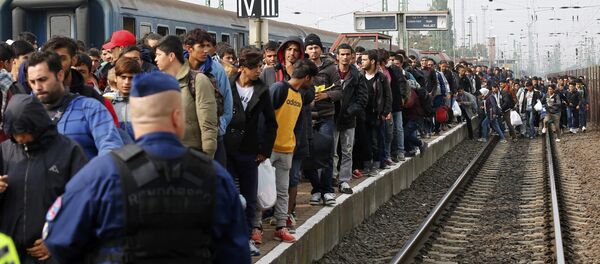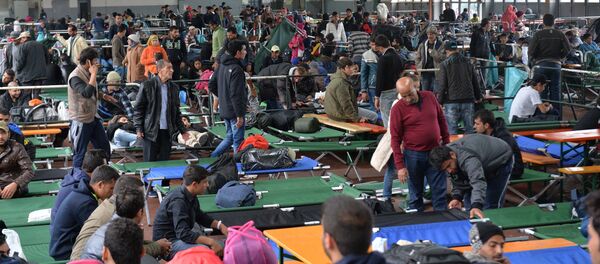MOSCOW (Sputnik), Marina Elagina — Over 911,000 refugees mostly from Syria, Afghanistan and Iraq arrived in Europe in the first eleven months of the year, the UN refugee agency estimated in early December.
Perils of Mediterranean Odyssey
The Mediterranean Sea has claimed some 3,500 lives this year, a quarter of them children, according to the UN refugee agency.
In one single week in April, some 1,200 refugees perished in two major migrant boat disasters in Libyan waters as they attempted to sail to Europe’s southern shores in dinghy boats.
On April 13, a boat carrying about 550 migrants from mostly sub-Saharan Africa capsized hours after leaving a Libyan port. Only 150 people were rescued, while the rest were presumed drowned, including many children.
The April tragedies were a wake-up call for the European Union and prompted calls to reinstate the large-scale search-and-rescue maritime operation that had been replaced last year over concerns that its focus on life-saving, rather than border control, had encouraged smugglers.
As a score of coffins containing bodies that had been retrieved by Italian rescuers arrived in Malta, the European Council convened on April 23 for the first in a series of emergency migrant meetings to prevent loss of life at sea and to stem the rising tide of undocumented arrivals.
Balkan Backdoor to Europe
The surging death toll along the central Mediterranean route from Libya to the European Union’s frontline member states – Italy, Malta and Greece – and the bloc’s increased efforts to protect its external border, including the launch of a new maritime operation in June, shifted the main migrant route to the Balkans.
Hundreds of thousands of migrants made their way from the Middle East and Asia through Turkey to Balkan states and further north into the European Union’s borderless Schengen Area. Asylum seekers typically travel by boat across the Aegean Sea to Greece and further on to Hungary through Macedonia and Serbia, or alternatively through Kosovo or Bulgaria.
Hungary, the key gateway to Europe’s 26-nation borderless zone, soon became overwhelmed by refugees who set up a camp in Budapest’s central railway station, demanding permission to travel further to more affluent Austria.
The two nations immediately opened their borders to welcome refugees who were bussed to Austria from Hungary and subsequently waved through to Germany – the preferred destination for asylum seekers, together with Sweden, mostly because of their open-door policy toward refugees.
This decision turned the Balkans into the key transit route for migrants from all over the Middle East, Asia and Africa, with thousands attempting the journey to Europe every day. Entire families set out on a quest to reach better-off Western and Northern European states, passing through an increasingly distraught Hungary.
The endless flood of migrants caused Budapest to shut its southern border with Serbia in September and deploy the army to guard the newly erected barbed-wire fence, despite condemnation from Brussels and neighboring EU states.
Hungary’s decision to shut down its border and the ensuing skirmishes between law enforcement and migrants along the fence, triggered a domino effect — rerouted the surging stream of migrants to the European Union’s non-Schengen member Croatia and further on to Austria through the small Alpine nation of Slovenia.
Border controls were reintroduced on the Austrian and Slovenian borders with Hungary and Croatia.
As the influx of refugees into Germany surged to 450,000 in September, Berlin gave in to pressure from its southern Bavarian state and tightened controls on its southern border after claims that Austria was allowing refugees to slip into Germany at night.
In December, Austria began building a fence along its border with Slovenia to better control the inflow of migrants
A month earlier, Slovenian authorities announced that they had started building a fence on the country’s border with Croatia to tackle illegal immigration.
The same month, Croatia, Slovenia, Serbia and Macedonia announced their decisions to shut their doors to economic migrants allowing entry only to refugees from crisis-hit countries.
To make the trip to Europe, thousands of refugees have been forced to seek the assistance of human traffickers, in what has become a lucrative business. In August, Austrian police found a refrigerator truck parked near the Hungarian border with 71 decomposing bodies, thought to be those of Syrian refugees. The next day, three severely dehydrated Syrian children and several adults were rescued from a smuggler’s van close to the German border.
On October, 25, several EU leaders held "Balkan talks" with their counterparts from non-EU Macedonia, Serbia and Albania, where they discussed how to better control the stream of migrants, but no quick fix was agreed.
Relocation, Resettlement & Resentment
Faced with a huge inflow of migrants, the European Commission, the European Union’s executive body, put on the table a relocation and resettlement scheme that would see a total of 160,000 refugees from Italy, Greece, and Hungary distributed among EU members under binding quotas.
Germany was asked to take in roughly a quarter of that number, followed by France with 19 percent and Spain with 12 percent. The contribution of other EU member states was counted in single-digit numbers.
The initial May scheme for relocation missed its goal after Brussels unsuccessfully sought to secure the unanimous support of every member state.
Wrapping up his assessment of the state of the union during the September 9 speech before the European Parliament, Juncker had to admit that the bloc was "not in a good state."
"There is not enough Europe in this Union. And there is not enough Union in this Union. We have to change this. And we have to change this now," he said, as he made a case for a second emergency mechanism to relocate a further 120,000 people.
An informal EU summit on migration was held on September 23 to address the migrant crisis before it got any further out of hand.
Amid Germany’s calls to share the burden of accommodating immigrants, the European Commission pushed through a 10-point relocation plan, which was adopted by a majority despite stiff opposition from Central and Eastern European countries – the Czech Republic, Hungary, Slovakia, Poland, and Romania – who declared that they would not accept binding quotas and offered instead to take in as many refugees as their resources allowed.
Under the hard-fought EU plan, a group of 19 Eritrean asylum seekers were moved from Italy to Sweden in October, with the first relocation from Greece a month later. Around 30 refugees from Syria and Iraq were flown to Luxembourg on November 4.
The United Kingdom opted out of the European Commission’s binding quotas. The UK Home Office argued that it had taken in 216 Syrians under its Vulnerable Persons Relocation program since March 2014.
German Chancellor Angela Merkel warned fellow EU member states on November 25 that they should abide by the European Commission’s relocation scheme or face the collapse of the open-borders Schengen zone. She said the countries’ ability to share out refugees put Europe’s unity and its basic principle of free movement to the test.
Nevertheless, European Commission President Jean-Claude Juncker stated the same day that border controls between Central and Eastern EU states had rendered the Schengen zone partially comatose.
"The Schengen system is partially comatose," Juncker stated. "Those who believe in Europe and its values, in its principles and freedoms must try, and try they will, to reanimate the Schengen spirit."
Enemy at the Gates
The hard-to-control flow of migrants, who often arrive in Europe without identification papers, has raised concerns among governments and security experts that Islamist militants could infiltrate the EU bloc by hiding among refugees, many of them from war-torn Syria.
Intelligence analysts warned as early as in May that radicals linked to the Islamic State terror group (IS, or Daesh in Arabic) – outlawed in the European Union, Russia, the United States and many other countries – could mix in with the boatloads of migrants coming ashore to Italy and Greece.
The deadly terrorist attacks in Paris on November 13 exacerbated these fears, after Greek media reports claimed that two of the IS-associated suicide bombers who blew themselves up outside the Stade de France stadium came to Europe from Turkey through Greece’s island of Leros, where a "hotspot" refugee processing center is located.
On November 29, EU leaders met with their Turkish counterpart to discuss the importance of stemming the flow of immigrants and urge Ankara to shut its northern borders to thousands of migrants seeking access to Europe.
The European Union said it was committed to providing Turkey with 3 billion euro in funds ($3.3 billion at the current exchange rate) to support the Syrian refugees residing there. Turkey is estimated to be currently hosting 2.2 million Syrians. In exchange, Brussels has promised to accelerate Ankara’s bid to join the bloc and the Schengen area.







